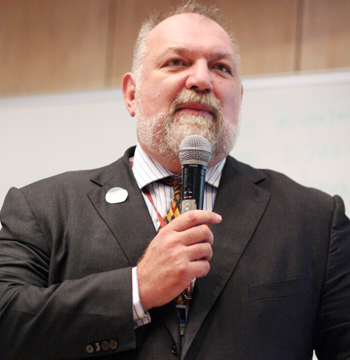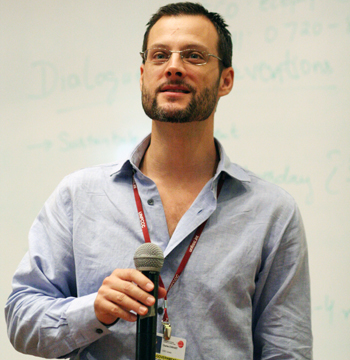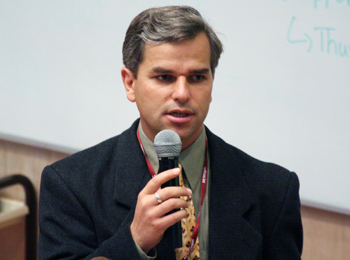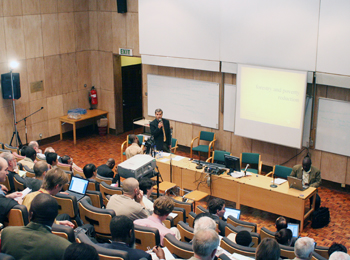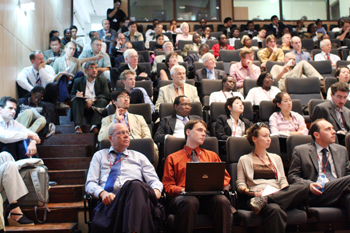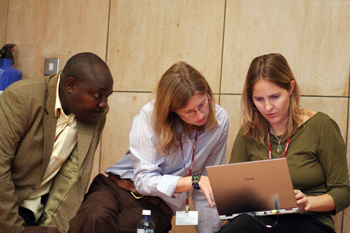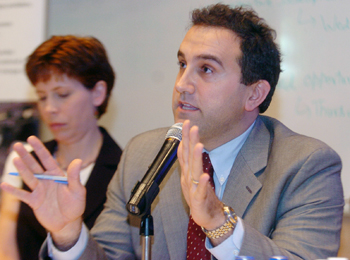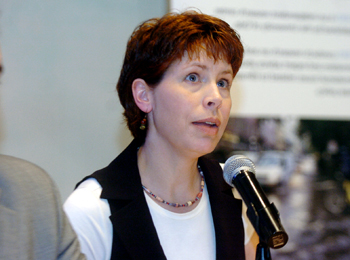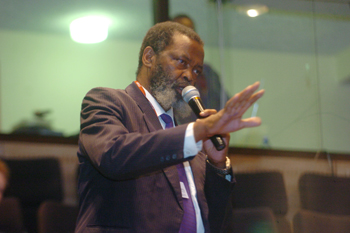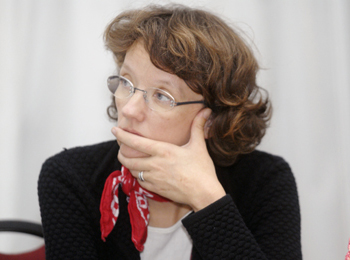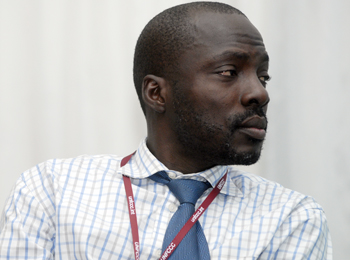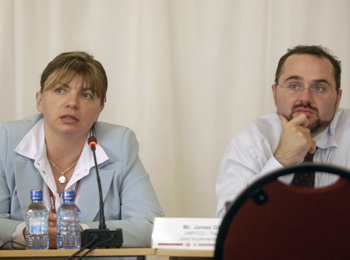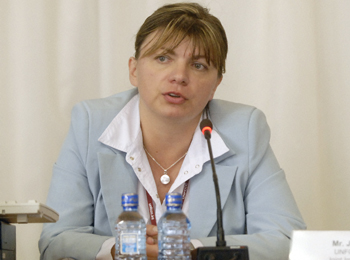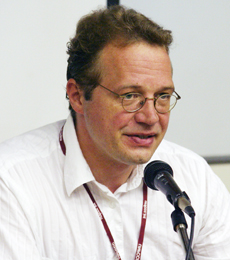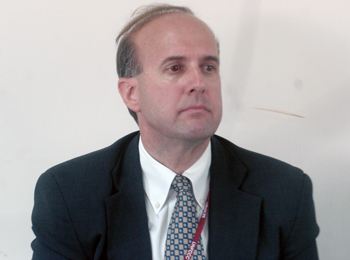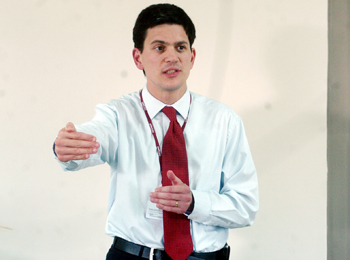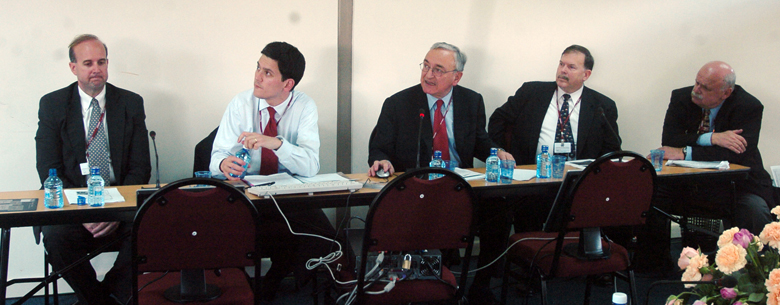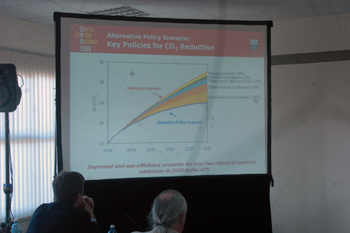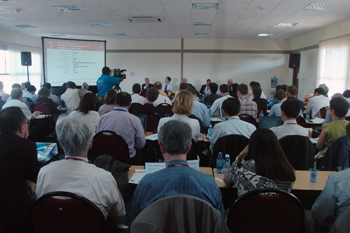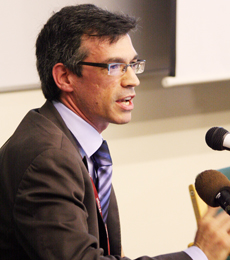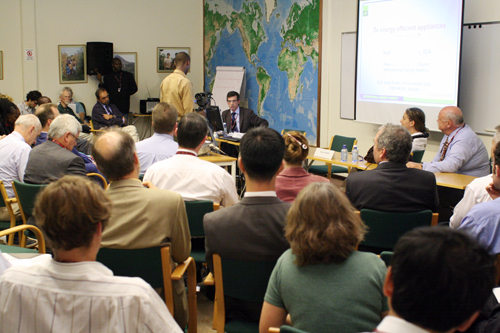 |
||
|
Published by the International Institute for Sustainable Development (IISD)
|
|||
|
A Special Report on Selected Side Events at the Second Conference of the Parties serving as the Meeting of Parties to the Kyoto Protocol (COP/MOP 2) and Twelfth Conference of the Parties (COP 12) to the UN Framework Convention on Climate Change (UNFCCC)
|
|||||
| 6-17 November 2006 | Nairobi, Kenya | |||||
 |
|||
 |
|||
Events convened on Tuesday, 14 November 2006
|
CDM Forestry: climate change mitigation and adaptation benefits for poor and vulnerable communities Presented by Conservation International |
|||
|
Charles Ehrhart, CARE International, emphasized that well-designed forestry projects can deliver unique benefits for poor communities. He emphasized the growing gap between what is delivered by Overseas Development Assistance (ODA) and what is needed by the Millennium Development Goals (MDGs) and suggested that funds from the carbon markets could be deployed for forestry projects.
John Begumana, Uganda National Forestry Authority, focused on community forestry in the carbon market. He elaborated on good practices learned from small-holder forestry and agriculture projects in Africa, including some innovations designed and obstacles faced. Toby Janson-Smith, Climate, Community and Biodiversity Alliance, argued that many current climate projects demonstrate negative trade-offs between climate, biodiversity and community concerns. He discussed the creation of “climate community and biodiversity standards” for assessing forestry projects. He noted that they apply to all forest types, provide investors with a risk management tool and enhance the credibility of the land use, land-use change and forestry (LULUCF) sector. Tom Spencer, Institute for Environmental Security, urged European governments to include forests in the EU Emission Trading Scheme (EU ETS) for the post-Kyoto period, without waiting for negotiations on future commitments. He suggested that along with fair trade, “fair forests” can help build bridges in the relationship between developed and developing countries. Benoit Bosquet, World Bank, presented on how CDM forestry rules can be reformed in the post-2012 framework. He emphasized that the current eligibility of forestry projects is limited in CDM and that CDM/JI rules need to be reformed to include options such as reduced deforestation, revegetation and soil carbon management. Highlighting the urgent need to address tropical deforestation, Ian Swingland, Sustainable Forestry Management, noted that his company is engaged in building value for emerging environmental markets and outlined his company’s efforts to address forestry issues in Borneo. Participants discussed the heightened political sensitivity to climate change and the possibility of addressing the cultural survival of marginalized indigenous people. |
|||
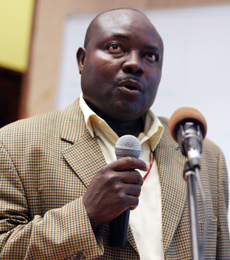 |
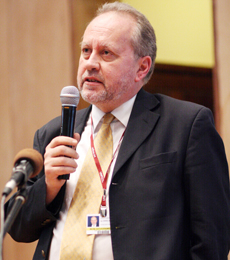 |
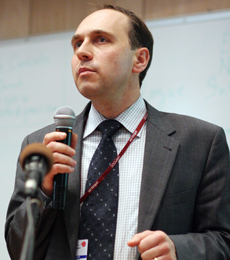 |
|||||
|
John Begumana, Uganda National Forestry Authority
|
Ian Swingland, Sustainable Forestry Management
|
Benoit Bosquet, World Bank
|
|||||
|
|||
|
Communicating climate change Presented by CICERO |
|||
|
Alister Doyle, Reuters, noted the importance of the Stern Report, which indicated that the effect of global warming might be similar to wars.
RK Pachauri, IPCC, noted that the key challenges to communicating climate science include reaching out to a very diverse audience and the complexity of the message that needs to be delivered. He outlined several communication bottlenecks such as capacity constraints within the IPCC and competition with other “sensational” news. Pål Prestrud, Center for International Climate and Environmental Research, noted the strong political impact made by the Arctic Climate Impact Assessment (ACIA), emphasizing that the assessment engaged an active participation of diverse stakeholders and the inclusion of traditional knowledge. Jules Boycoff, Pacific University, stressed that there is an “informational bias” in the US media reporting on climate change issues. He noted that the report style used by US media shows that there still exists a debate on climate change and its human causes, and emphasized that this pattern of reporting became very salient after the 1990s. Marc Morano, Environmental and Public Works, US Senate, elaborated that if a similar kind of UN, governmental and "alarmist" media involvement had taken place in the 1970s as has taken place in the case of climate change, there would have been an ice age scare. Liisa Antilla, US, highlighted the role played by the US media in creating "disinformation" on climate change. She suggested that the public relations "machine" in the US has been funded by the industry. Panelists debated on the objectivity of the IPCC review process. Participants discussed whether IPCC has conducted any research on the formulation of truths and decision making and the role religious leaders play in communicating climate science. |
|||
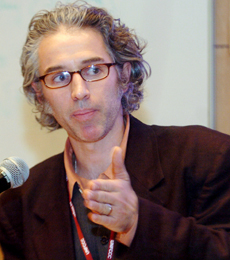 |
 |
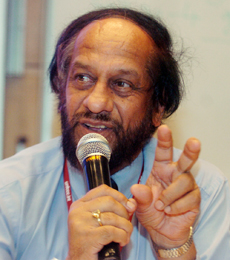 |
|||||
|
Jules Boycoff, Pacific University
|
Pål Prestrud, Center for International Climate and Environmental Research
|
RK Pachauri, IPCC
|
|||||
|
|||
|
Africa monsoons and climate change Presented by the European Union |
|||||
|
Elisabeth Lipiatou, European Commission (EC), highlighted the EU Programme on African Monsoon Multidisciplinary Analyses (AMMA), which aims to improve the ability to predict the weather and climate in West Africa. On behalf of Dimas Stavros, European Commissioner for Environment, Lipiatou noted the importance of reducing the impacts of variability and trends in the West Africa monsoons. Lipiatou noted AMMA aims to promote collaboration among African countries and build a network for weather forecasting. She also underscored the importance of building local capacity to generate information and manage crisis situations. Amadou Gaye, University of Cheikh Anta Diop, Senegal, said rainfall fluctuation in West Africa has a profound and fundamental impact on the hydrological cycle and that the rainy season determines life and environmental conditions in the region. He outlined the scientific strategy of AMMA, which focuses on improving monsoon forecasting, achieving improved seasonal- and inter-annual predictions; and analyzing how monsoons impact food security in the region. Jan Polcher, Institut Pierre Simon Laplace, France, stressed that West Africa is a region in which a good knowledge of surface conditions is key for seasonal predictions and in which no model is able to properly forecast rainfall. He said the latest generation of IPCC’s simulations offers contradictory results for the Sahel region, making it more difficult to inform decision makers. Polcher underscored AMMA will find new ways to increase confidence in models and their sensitivity. Inge Sandholt, University of Copenhagen, highlighted socioeconomic impacts of climate and adaptation strategies in West Africa. She noted the importance of local knowledge and said AMMA works on land productivity, human strategies and adaptation capacities, water resources, health and vulnerability assessments. |
|||||
|
|||
|
Joint Implementation project cycle: from a project idea to the market Presented by UNFCCC |
|||
|
Daniela Stoycheva, Chair of the Joint Implementation Supervisory Committee (JISC), highlighted that the Joint Implementation (JI) Track 2 process was launched on 26 October, 2006 and that the accreditation procedures of independent entities will enter into force on 15 November, 2006.
Björn Zapfel, UNFCCC, explained that Track 1 projects meet all eligibility requirements and are verified according to host party rules, whereas Track 2 projects meet basic eligibility requirements and are verified under the JISC. He emphasized that all host parties can always choose Track 2. Manfred Stockmayer, Camco International Ltd., underscored that the potential for indirect double counting of carbon benefits can hinder JI projects in several categories. Alexander Fediaev, Nova-Eco, described Nova-Eco’s success in attracting investment for a 300 MW wind power project within the JI framework. Thomas Kleiser, TÜV SÜD Group, said that many JI projects have well-developed Project Development Documents in initial phases of validation. He highlighted as common “pitfalls,” inter alia, limited understanding of additionality and problems in defining project boundaries correctly to include all emission sources. Olga Gassan-zade, Point Carbon, noted that: 64% of buyers of JI credits are governments and animal waste management projects are an unexplored opportunity for JI. Ash Sharma, Nordic Environment Finance Corporation, explained that buyers of Assigned Amount Units are looking for acceptable risk profiles in JI projects, but that buyers are dependent on domestic approval procedures, which have been a constraint, particularly in Russia. |
|||
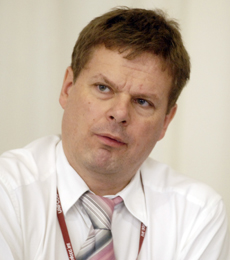 |
 |
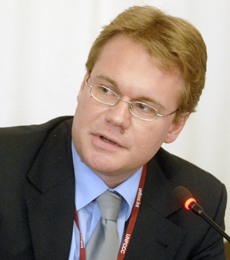 |
|||||
|
Thomas Kleiser, TÜV SÜD Group
|
Alexander Fediaev, Nova-Eco
|
Björn Zapfel, UNFCCC
|
|||||
|
|||
|
Sustainable transport and the CDM Presented by Wuppertal Institute for Climate, Environment and Energy |
|||
|
Wolfgang Sterk, Wuppertal Institute for Climate, Environment and Energy, presented a study on “driving” the CDM into a sustainable transport future. He noted that the transport sector is the fastest growing source of GHG emissions. He added that re-orienting transport trends in developing countries poses a challenge for climate protection. Sterk highlighted the current status of transport in CDM, stating that of almost 1,300 projects in the pipeline, only two are transport projects and five of nine transport projects that submitted proposals for new methodologies were rejected.
Holger Dalkmann, Wuppertal Institute for Climate, Environment and Energy, outlined strategies for sustainable transport, such as shifting to sustainable transport modes and transport efficiency. He cited the UK “Strategic Environmental Assessment” as an example of a planning instrument, the European Automobile Manufactures Association Agreement as a regulative instrument and the congestion charge in London as an economic instrument towards sustainable transport. Lew Fulton, UNEP, stressed the complexity of urban transport projects, noting that the net policy impacts are difficult to gauge. Emilio Lèbre La Rovere, Centro Clima, Brazil, cautioned that forward-looking baselines are difficult to establish for the transport sector given that markets are averse to uncertainties. John Drexhage, International Institute for Sustainable Development, expressed concern that energy efficiency and transportation are not being properly advanced within the CDM due to its project structure. Bettina Wittneben, Erasmus University, lamented the lack of synergy between CDM and transport policy. |
|||
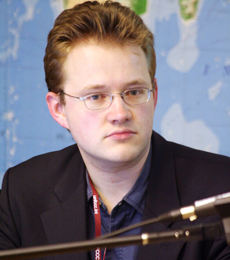 |
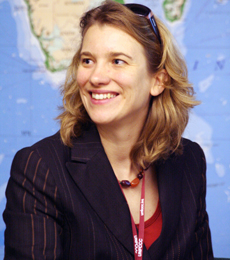 |
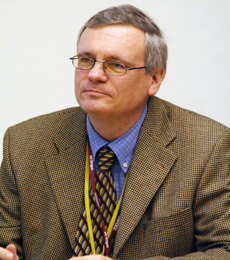 |
|||||
|
Wolfgang Sterk, Wuppertal Institute for Climate, Environment and Energy
|
Bettina Wittneben, Erasmus University
|
Lew Fulton, UNEP
|
|||||
|
|||
|
Energy and climate change: G8 Gleneagles plan of action Presented by United Kingdom |
|||
|
David Miliband, Secretary of State for Environment, Food and Rural Affairs, UK, explained that the Gleneagles process grew from the need to establish a forum, outside of the UNFCCC, to bring together governments, experts and civil society to discuss climate change and how it can be addressed under the principle of “common but differentiated responsibilities.”
Claude Mandil, International Energy Agency (IEA), outlined results from the “World Energy Outlook 2006” report, which contains scenarios based on improved technologies demonstrating that over two thirds of carbon dioxide emission reductions can come from improved end-use energy efficiency, which is cost effective and promotes energy security. Warren Evans, World Bank, outlined the three pillars of the World Bank’s Clean Energy Investment Framework. On the first pillar, access to energy for development, he stated that funding mechanisms currently exist but are insufficient. On the second pillar, transitioning to a low carbon future, he argued that new financing mechanisms will be required. On the third pillar, investments to reduce vulnerability, he said funding would come mainly from ODA. Richard Bradley, IEA, presented on measures that can improve energy efficiency by 2010. He described IEA’s efforts to reduce standby power to 1-Watt, emphasizing the need to harmonize energy policies across countries to achieve this goal. Robert Dixon, IEA, summarized results from the 2006 “Energy Technology Perspectives.” He stressed the importance of a “technology portfolio” for emission reductions and argued that CCS is key for a sustainable energy future. Participants commented on “conservative” emission reductions laid out in the IEA scenarios and the small role that renewables play in this regard. |
|||
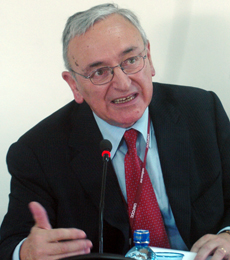 |
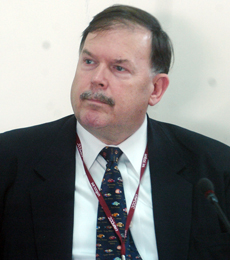 |
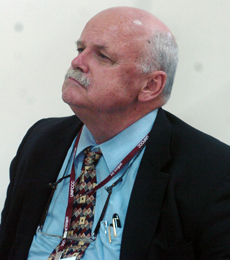 |
|||||
|
Claude Mandil, International Energy Agency (IEA)
|
Warren Evans, World Bank
|
Richard Bradley, IEA
|
|||||
|
|||
|
Latest work from the International Energy Agency Presented by IEA |
|||
|
Richard Bradley, IEA, highlighted the results of a study on the effect of price controls on investment incentives, and noted that government-established incentives do not always yield the expected outcomes due to uncertainties in fuel prices. He presented a model for analyzing investment under uncertainty, concluding that: price “caps and floors” can reduce effects of uncertainty if caps and floors themselves are certain; extending the period of “stable” prices from five to 10 years has the strongest effect on reducing the investment threshold; and carbon price caps decrease the expected average income for low carbon technologies.
Maria Argiri, IEA, overviewed this year’s “World Energy Outlook 2006” report, and highlighted the chapters on the impact of high oil prices, nuclear power, unsustainable use of traditional biomass and the supply side of biofuels. Argiri stated that considerable political will, private sector support and international cooperation are essential for adoption and implementation of an alternative policy scenario. Richard Baron, IEA, presented a study on the cost of energy efficient appliances, which compares national data from tracking of energy regulatory programs in the US, Japan, EU and Australia since the 1980s. Baron summarized the findings, which showed that consumers are paying less for more efficient appliances and are getting increased levels of service. He said that these findings are consistent for all concerned countries due to mandatory regulations and energy performance standards. He concluded that if appropriate notice is given by governments, energy efficiency requirements can be absorbed into design processes with little or no cost. |
|||
|
|||
|
||
|
Click the above button to go back to our ENB main coverage
|
||
|
|
|
|
|
||
|
